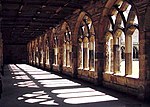South Street (Durham)
Buildings and structures in Durham, EnglandCounty Durham geography stubsStreets in England
South Street is an affluent residential street in Durham, England, on the banks of the River Wear. It overlooks the Durham Cathedral, a UNESCO World Heritage Site, and Durham Castle. It is best known for its terraced houses, many of which are Grade II listed buildings built in the Tudor Revival architecture and architecture of the modern era. The street is situated in a conservation area and runs 0.5 km from Pimlico near Durham School to the Church of St Margaret of Antioch and Framwellgate Bridge. It is in walking distance from the Durham city centre.
Excerpt from the Wikipedia article South Street (Durham) (License: CC BY-SA 3.0, Authors).South Street (Durham)
South Street, Durham Viaduct
Geographical coordinates (GPS) Address Nearby Places Show on map
Geographical coordinates (GPS)
| Latitude | Longitude |
|---|---|
| N 54.774081 ° | E -1.580222 ° |
Address
South Street 48
DH1 4QP Durham, Viaduct
England, United Kingdom
Open on Google Maps








